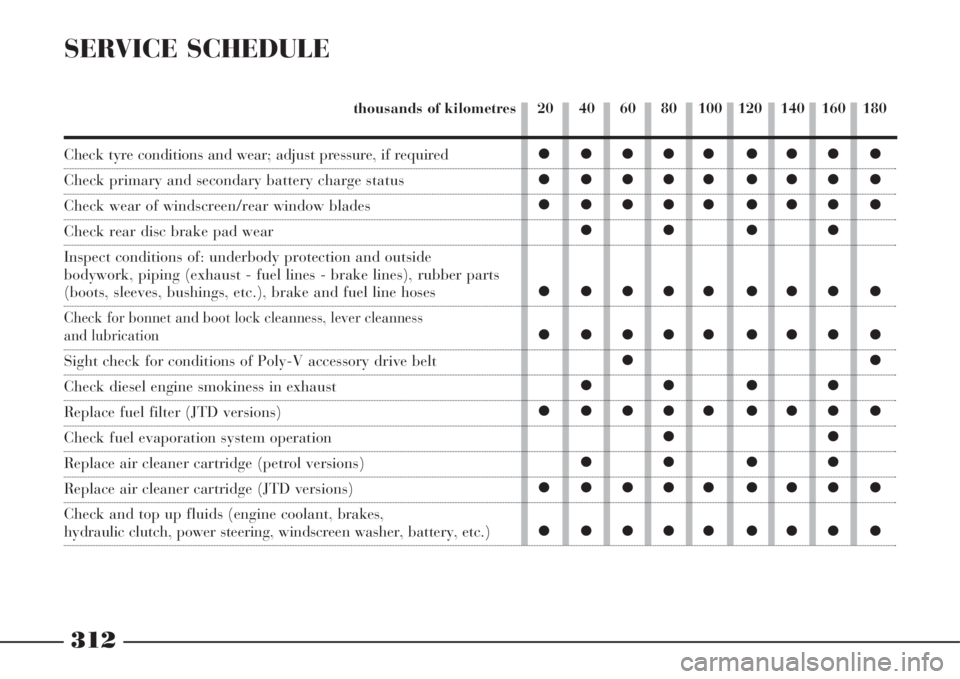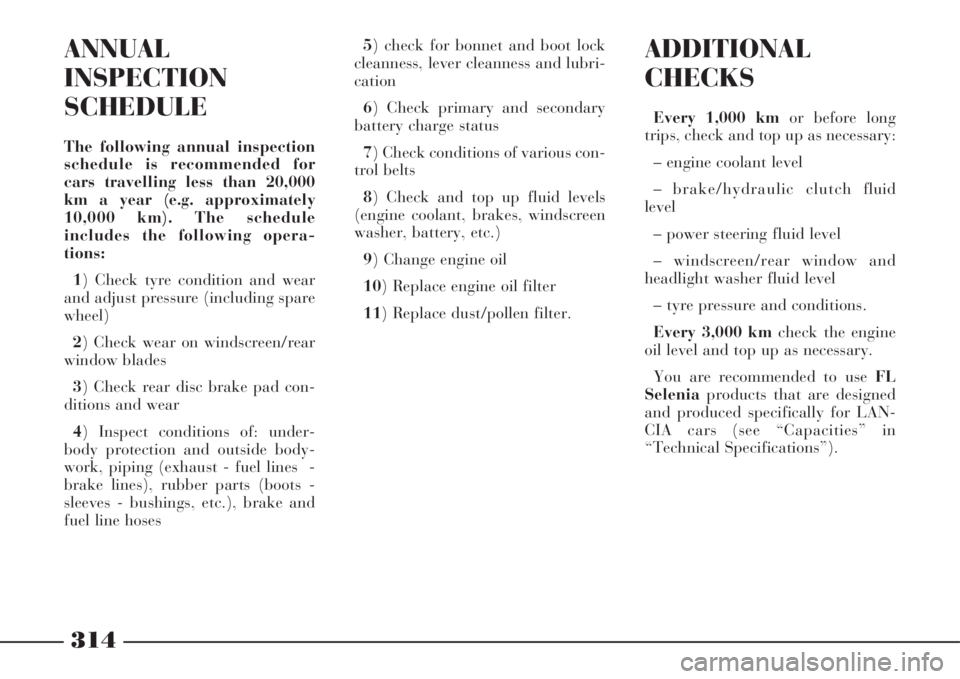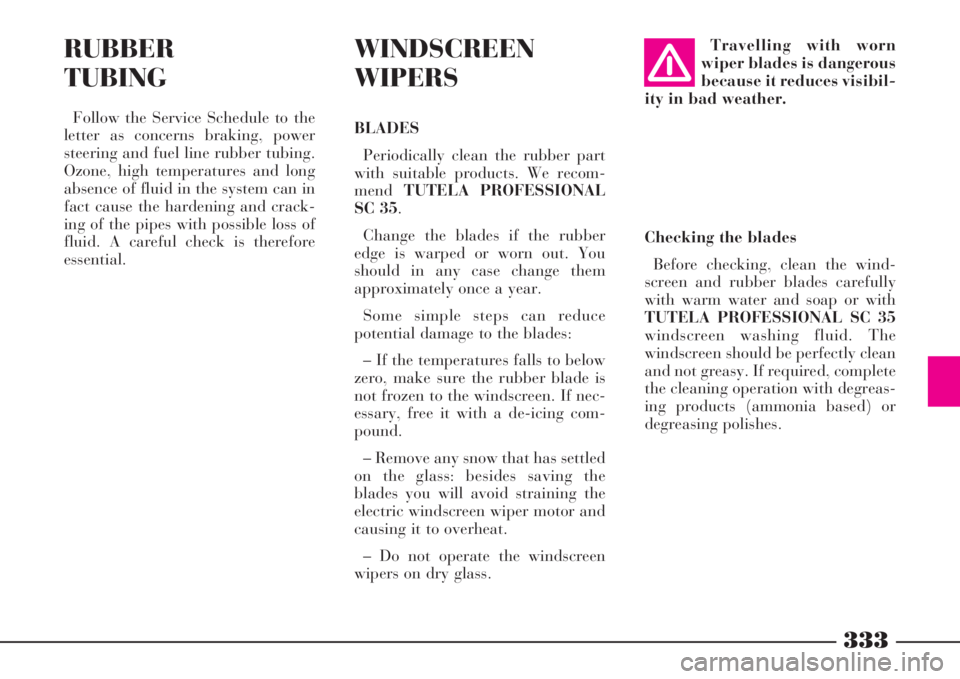steering Lancia Thesis 2009 Owner handbook (in English)
[x] Cancel search | Manufacturer: LANCIA, Model Year: 2009, Model line: Thesis, Model: Lancia Thesis 2009Pages: 386, PDF Size: 4.96 MB
Page 313 of 386

312
SERVICE SCHEDULE
20 40 60 80 100 120 140 160 180 thousands of kilometres
ççççç çççç
ççççç çççç
ççççç çççç
çç çç
ççççç çççç
ççççç çççç
çç
çç çç
ççççç çççç
çç
çç çç
ççççç çççç
ççççç ççççCheck tyre conditions and wear; adjust pressure, if required
Check primary and secondary battery charge status
Check wear of windscreen/rear window blades
Check rear disc brake pad wear
Inspect conditions of: underbody protection and outside
bodywork, piping (exhaust - fuel lines - brake lines), rubber parts
(boots, sleeves, bushings, etc.), brake and fuel line hoses
Check for bonnet and boot lock cleanness, lever cleanness
and lubrication
Sight check for conditions of Poly-V accessory drive belt
Check diesel engine smokiness in exhaust
Replace fuel filter (JTD versions)
Check fuel evaporation system operation
Replace air cleaner cartridge (petrol versions)
Replace air cleaner cartridge (JTD versions)
Check and top up fluids (engine coolant, brakes,
hydraulic clutch, power steering, windscreen washer, battery, etc.)
Page 315 of 386

314
ADDITIONAL
CHECKS
Every 1,000 kmor before long
trips, check and top up as necessary:
– engine coolant level
– brake/hydraulic clutch fluid
level
– power steering fluid level
– windscreen/rear window and
headlight washer fluid level
– tyre pressure and conditions.
Every 3,000 kmcheck the engine
oil level and top up as necessary.
You are recommended to use FL
Seleniaproducts that are designed
and produced specifically for LAN-
CIA cars (see “Capacities” in
“Technical Specifications”).
ANNUAL
INSPECTION
SCHEDULE
The following annual inspection
schedule is recommended for
cars travelling less than 20,000
km a year (e.g. approximately
10,000 km). The schedule
includes the following opera-
tions:
1) Check tyre condition and wear
and adjust pressure (including spare
wheel)
2) Check wear on windscreen/rear
window blades
3) Check rear disc brake pad con-
ditions and wear
4) Inspect conditions of: under-
body protection and outside body-
work, piping (exhaust - fuel lines -
brake lines), rubber parts (boots -
sleeves - bushings, etc.), brake and
fuel line hoses5) check for bonnet and boot lock
cleanness, lever cleanness and lubri-
cation
6) Check primary and secondary
battery charge status
7) Check conditions of various con-
trol belts
8) Check and top up fluid levels
(engine coolant, brakes, windscreen
washer, battery, etc.)
9) Change engine oil
10) Replace engine oil filter
11) Replace dust/pollen filter.
Page 318 of 386

317
CHECKING
FLUID LEVELS
1) Engine oil
2) Brake fluid
3) Windscreen/rear window and
headlight washer fluid
4) Engine coolant
5) Power steering fluid
L0A0343b
L0A0344b
fig. 1 - 2.0 TB version
fig. 2 - 2.4 - 2.4 CAE versions
Page 319 of 386

318
1) Engine oil
2) Brake fluid
3) Windscreen/rear window and
headlight washer fluid
4) Engine coolant
5) Power steering fluid
L0A0345b
L0A0341b
fig. 3 - 2.4 JTD version
fig. 4 - 2.4 JTD
20V- 2.4 JTD 20VCAE versions
Page 320 of 386

319
1) Engine oil
2) Brake fluid
3) Windscreen/rear window and
headlight washer fluid
4) Engine coolant
5) Power steering fluid
L0A0342b
L0A0358b
fig. 5 - 3.0 V6 CAE version
fig. 6 - 3.2 V6 CAE version
Page 323 of 386

322
fig. 14
L0A0293b
fig. 15
L0A0158b
The engine cooling sys-
tem works with PARAFLU
UP. Top up only with the
same fluid contained in the cool-
ing circuit. PARAFLU UP cannot
be mixed up with PARAFLU 11 or
other fluids. Should this take
place, do not start the engine and
contact a Lancia Dealership. In
case of need, lacking the speci-
fied fluid, top up with water and
contact a Lancia Dealership to
have the proper proportions
restored.
The cooling system is
pressurised. If necessary,
replace the cap with a
genuine spare part to avoid com-
promising the system efficiency.
The mixture of distilled water
and PARAFLU gives freeze pro-
tection down to -35°C. POWER STEERING FLUID
(fig. 14-15)
Fluid level in the reservoir should
be at the maximum.
This check should be performed
when the engine is cold and with the
car on level ground.
For topping up, remove cap A,
after loosening the fastening screws
Bwith the wrench provided (in the
tool bag), then remove hose Cand
loosen cap D.
Check that the level reaches the
MAXreference line on the dipstick
integral with the reservoir cap (for
cold check use the level indicated on
the 20 °C side of the dipstick).If the fluid level in the reservoir is
below the specified one, top up only
with one of the products shown in
table “Fluids and lubricants” in
chapter “Technical Specifications”
proceeding as follows:
– Start the engine and wait for the
oil level in the reservoir to stabilise.
– With the engine running, turn the
steering wheel lock to lock a few
minutes.
– Top up to the MAXreference line
and then refit the cap D.
Page 324 of 386

323
Oil consumption is ex-
tremely low. If the oil level
needs topping up again af-
ter a short period of time, have the
system checked for leakage at a
Lancia Dealership.BRAKE AND HYDRAULIC
CLUTCH FLUID (fig. 16)
Unscrew cap A: check that the fluid
level in the reservoir is at maximum.
Fluid level in the reservoir shall not
exceed the MAXmark.
If fluid has to be added, it is sug-
gested to use the brake fluid in table
"Fluids and lubricants" (see chapter
"Technical characteristics").
NOTEClean accurately the tank cap
Aand the surrounding surface.
Prevent brake fluid, which
is highly corrosive, from
coming into contact with
painted parts. Should it happen,
immediately wash with water.
Do not let the power
steering fluid come into
contact with hot engine
parts. It catches fire very easily.
fig. 16
L0A0294b
– Refit hose C.
– Refit cap Aand check for seal
proper positioning into its seat, then
secure the cap with screws B.At plug opening, pay maximum at-
tention in order to prevent any impu-
rities from entering the tank.
For topping up, always use a funnel
with integrated filter with mesh equal
to or lower than 0.12 mm.
IMPORTANT Brake fluid absorbs
moisture, for this reason, if the car is
mainly used in areas with a high de-
gree of atmospheric humidity, the
fluid should be replaced at more fre-
quent intervals than specified in the
“Service schedule”.
Page 333 of 386

332
If you replace a tyre it is a good
idea to change the inflation valve,
too.
To ensure the front and rear tyres
all wear evenly, you are advised to
change the tyres over every 10-15
thousand kilometres, keeping them
on the same side of the car so as to
not reverse the direction of rotation.
Do not change the tyres
over in criss-cross fash-
ion by moving a tyre from
the left hand side of the car to the
right and vice versa.GENERAL NOTES
As far as possible, avoid sharp
braking and screech starts, etc.
Be careful not to hit the kerb, pot-
holes or other obstacles hard.
Driving for long stretches over
bumpy roads can damage the tyres.
Periodically check that the tyres
have no cuts in the sidewalls, abnor-
mal swelling or irregular tyre wear.
If any of these occur, have the car
seen to at a Lancia Dealership.
Avoid overloading your car: this
can seriously damage wheels and
tyres.If you get a flat tyre, stop immedi-
ately and change it so as not to dam-
age the tyre, the wheel, the suspen-
sion and the steering. Tyres age even
if they are not used very much.
Cracking of the tread rubber and the
sidewalls are a sign of this ageing. In
any case, if the tyres have been fitted
for more than six years they should
be examined by an expert who can
judge whether they are still fit for
use. Remember to check the spare
tyre particularly carefully too
If a replacement is necessary,
always use new tyres and avoid
using ones the origin of which you
are not certain about.
Lancia THESIS fits tubeless tyres.
Under no circumstances use an inner
tube with these tyres.
Page 334 of 386

333
RUBBER
TUBING
Follow the Service Schedule to the
letter as concerns braking, power
steering and fuel line rubber tubing.
Ozone, high temperatures and long
absence of fluid in the system can in
fact cause the hardening and crack-
ing of the pipes with possible loss of
fluid. A careful check is therefore
essential.
WINDSCREEN
WIPERS
BLADES
Periodically clean the rubber part
with suitable products. We recom-
mendTUTELA PROFESSIONAL
SC 35.
Change the blades if the rubber
edge is warped or worn out. You
should in any case change them
approximately once a year.
Some simple steps can reduce
potential damage to the blades:
– If the temperatures falls to below
zero, make sure the rubber blade is
not frozen to the windscreen. If nec-
essary, free it with a de-icing com-
pound.
– Remove any snow that has settled
on the glass: besides saving the
blades you will avoid straining the
electric windscreen wiper motor and
causing it to overheat.
– Do not operate the windscreen
wipers on dry glass.Travelling with worn
wiper blades is dangerous
because it reduces visibil-
ity in bad weather.
Checking the blades
Before checking, clean the wind-
screen and rubber blades carefully
with warm water and soap or with
TUTELA PROFESSIONAL SC 35
windscreen washing fluid. The
windscreen should be perfectly clean
and not greasy. If required, complete
the cleaning operation with degreas-
ing products (ammonia based) or
degreasing polishes.
Page 338 of 386

337
Detergents pollute water.
For this reason the car
must be washed in an
area equipped for the collection
and purification of the liquids
used while washing.TIPS FOR KEEPING THE BODY
IN GOOD CONDITIONS
Paintwork
The paintwork is not only to make
your car look attractive but also to
protect the steel.
If the paint is scuffed or scratched
deeply you are therefore advised to
touch up as necessary to prevent rust
from forming.
Only use genuine products when
touching up the paintwork (see
“Bodywork paint identification
plate” in chapter “Technical
Specifications”).
Ordinary maintenance of the
paintwork means washing it. The
frequency you should do this
depends on the conditions and the
environment the car is driven in. For
example, you should wash your car
more often if it is driven in areas
with a high level of air pollution or
on road sprinkled with saltwash.Before leaving your car
into the automatic car-
wash tunnel, disengage
the parking brake following the
instructions given in the relevant
paragraph, and leave the Keyless
System CID (where fitted) in the
car to prevent automatic steering
locking.Before cleaning the
windscreen (e.g. at filling
stations), make sure to
have deactivated the rain sensor
and turned the ignition key to
STOP. Deactivate the rain sensor
also when washing your car man-
ually or at automatic carwash.